60%+ returns in 2025: Here’s how AI-powered stock investing has changed the game
Introduction & Market Context
First Abu Dhabi Bank (FAB) reported record profitability for the first half of 2025, with net profit surging 26% year-over-year to AED 10.63 billion. The bank’s Q2/H1 2025 earnings presentation, delivered on July 23, 2025, highlighted strong performance across key metrics and an upgrade to its full-year loan growth guidance from high single-digit to low double-digit growth.
Operating in a favorable macroeconomic environment with UAE real GDP growth projected at approximately 5.2% for FY25 and 5.6% for FY26, FAB has capitalized on regional economic strength while maintaining its AA- credit rating. The bank expects up to two interest rate cuts in H2’25 and three to four cuts in FY26, which it has factored into its financial planning.
Quarterly Performance Highlights
FAB delivered impressive second-quarter results, with profit before tax (PBT) increasing 36% year-over-year to AED 6.71 billion, driven primarily by strong revenue growth. Net profit after tax for Q2’25 reached AED 5.51 billion, up 29% from the same period last year.
The bank’s operating income for H1’25 reached AED 18.31 billion, representing a 16% increase year-over-year, with particularly strong growth in non-interest income, which surged 41% to AED 8.35 billion.
As shown in the following comprehensive income statement summary, FAB maintained strong profitability metrics while improving its cost-to-income ratio:
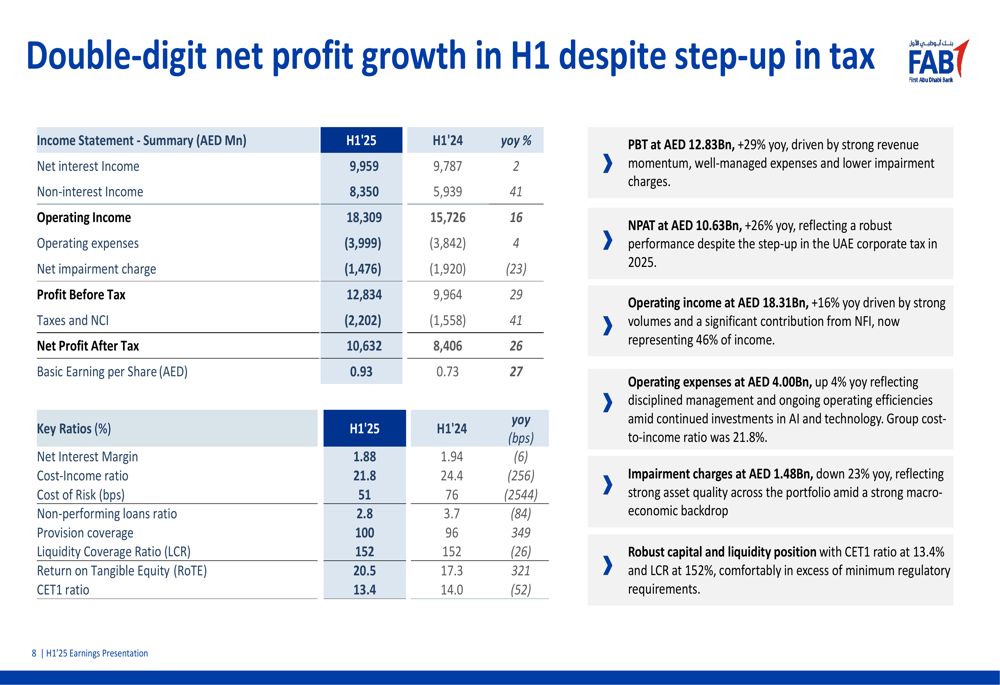
Return on Tangible Equity (RoTE) improved significantly to 20.5% for H1’25, up from 17.3% in H1’24, well above the bank’s medium-term target of >16%. The cost-to-income ratio improved to 21.8% from 24.4% in the same period last year, demonstrating enhanced operational efficiency.
Q2’25 results showed continued momentum with quarterly profit before tax up 10% compared to Q1’25 and 36% year-over-year:
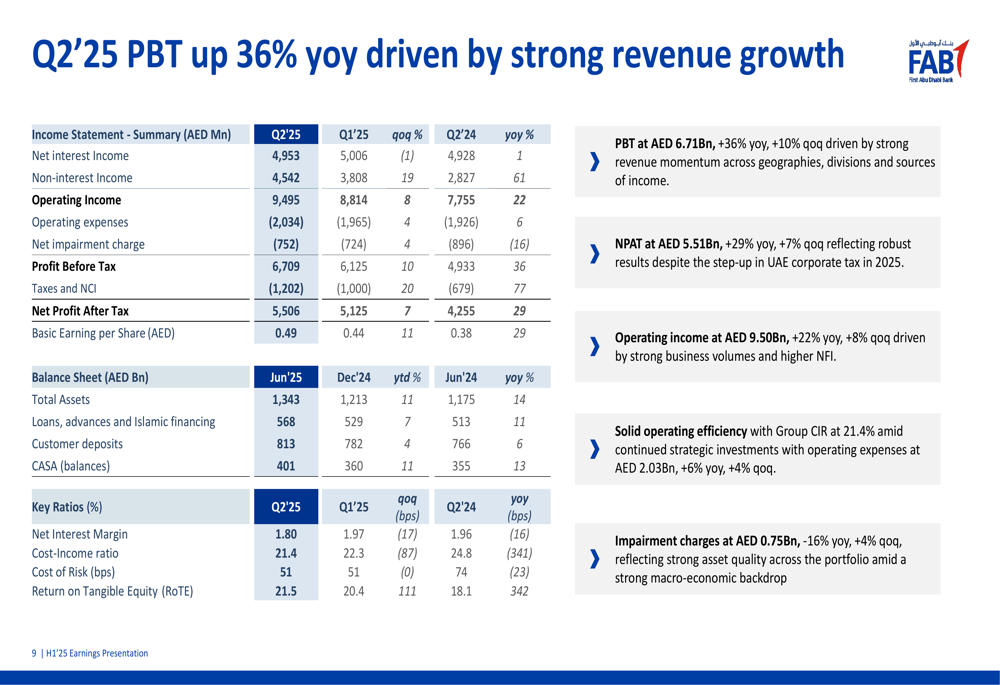
Detailed Financial Analysis
Revenue Diversification
FAB’s revenue growth has been supported by a well-diversified franchise. The Investment Banking & Markets division saw a 17% year-over-year increase in revenue to AED 6.1 billion for H1’25, while Wholesale Banking and Personal, Business, Wealth & Privileged Client Banking Group both recorded 12% growth.
The following chart illustrates the bank’s revenue distribution by division, geography, and income source:
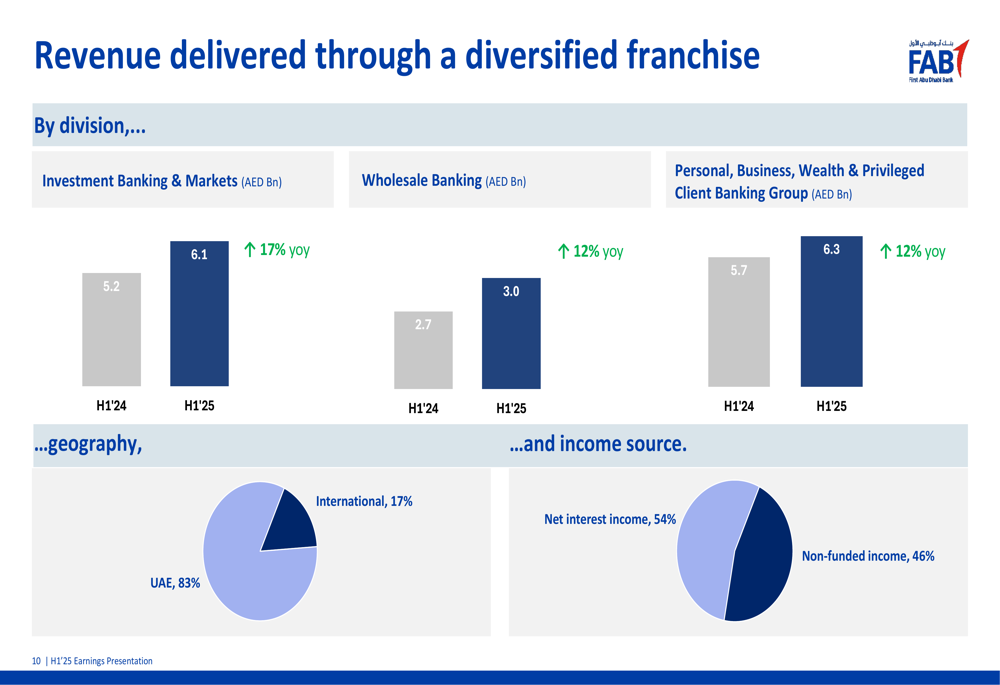
Non-interest income has shown particularly strong growth, with a 61% year-over-year increase in Q2’25 alone. This growth reflects the bank’s success in diversifying its revenue streams beyond traditional interest income.
The chart below demonstrates the strong upward trajectory in non-interest income:
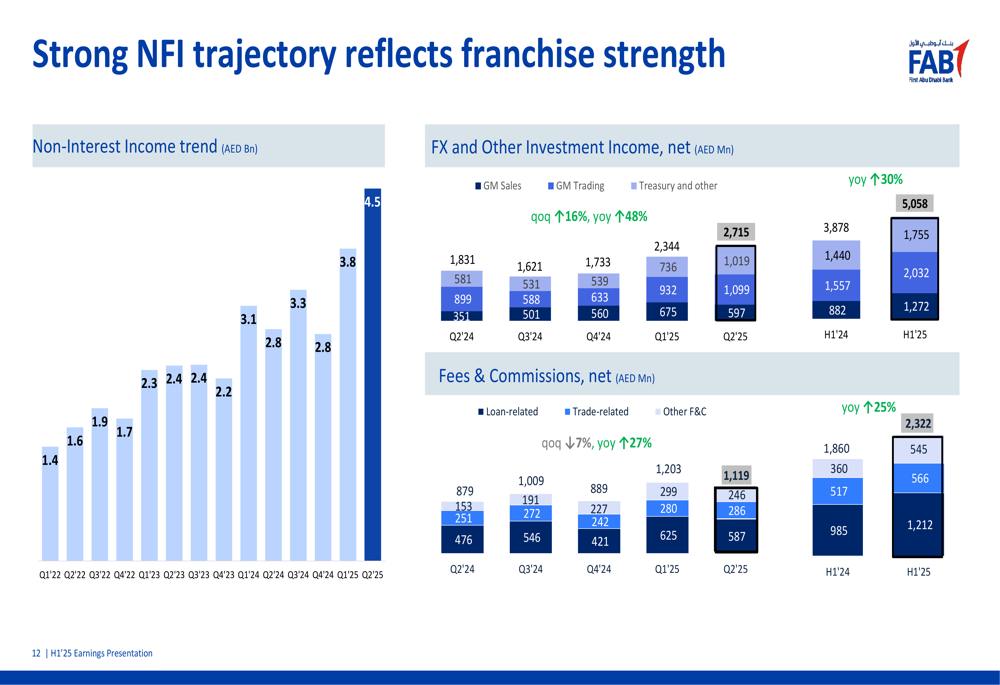
Balance Sheet Strength
FAB’s balance sheet showed robust growth, with total assets reaching AED 1.34 trillion as of June 2025, representing an 11% increase year-to-date and 14% year-over-year. Loans, advances, and Islamic financing grew by 7% year-to-date to AED 568 billion, while customer deposits increased by 4% to AED 813 billion.
The bank’s Current Account and Savings Account (CASA) balances crossed AED 400 billion, growing 11% year-to-date and 13% year-over-year, providing a stable and low-cost funding base.
The following chart details the bank’s balance sheet momentum:
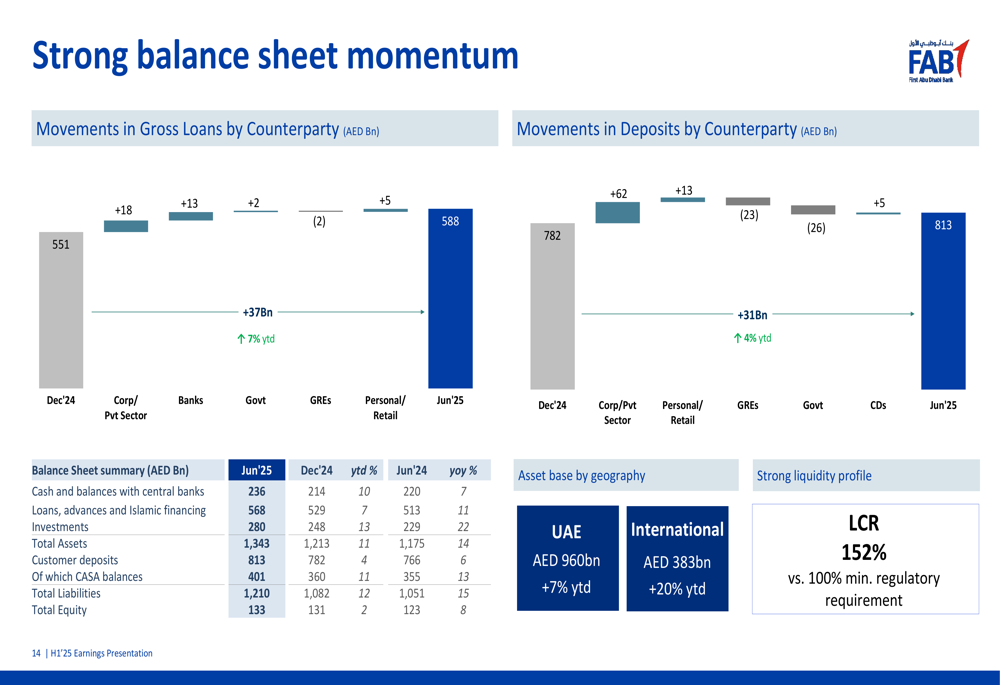
Asset Quality
FAB’s asset quality metrics showed significant improvement, with the non-performing loan (NPL) ratio decreasing to 2.8% as of June 2025, down from 3.7% a year earlier. The provision coverage ratio improved to 100%, up from 96% in June 2024.
Cost of Risk (CoR) decreased to 51 basis points in H1’25, down from 76 basis points in H1’24, reflecting the bank’s prudent risk management approach and improving economic conditions.
The following chart illustrates the improvement in asset quality metrics:
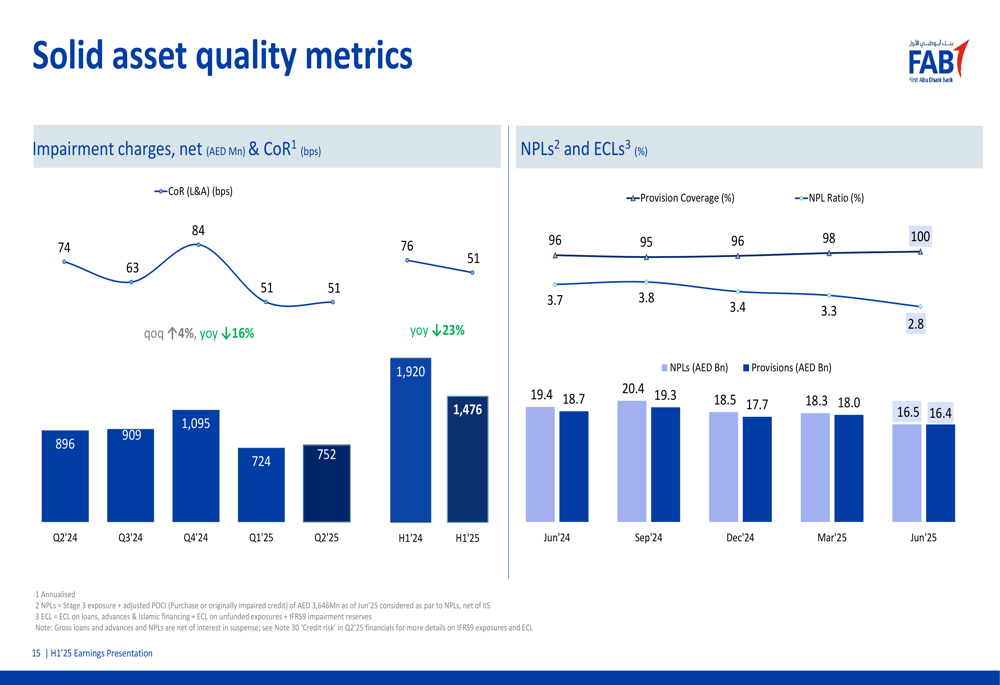
Strategic Initiatives
International Expansion
FAB has been actively expanding its international presence, with international franchise loans growing by 28% and deposits by 24% year-over-year. The international business now accounts for 17% of the bank’s revenue, with growth driven by priority markets including the UK, France, Switzerland, and Saudi Arabia.
The bank became the first MENA bank to join CIPS (Cross-Border Interbank Payment System) as a direct participant, strengthening its position in facilitating Asia and East-West corridor flows.
Digital Transformation and AI Adoption
FAB is accelerating its AI adoption journey, focusing on building foundational technology infrastructure and a modern data platform. The bank is leveraging AI-powered tools to boost productivity and enhance client engagement, including the implementation of a Board AI Observer, trade document validation tools, and distribution channel optimizers.
Despite continued investments in technology, the bank has maintained cost discipline, with operating expenses increasing by just 4% year-over-year to AED 3.99 billion in H1’25, while improving its cost-to-income ratio.
Sustainable Finance
The bank has made significant progress in sustainable finance, with AED 318 billion in sustainable and transition financing to date, representing 64% of its AED 500 billion 2030 target. This commitment aligns with regional and global sustainability initiatives and positions FAB as a leader in sustainable finance in the MENA region.
Forward-Looking Statements
FAB has upgraded its full-year 2025 loan growth guidance from high single-digit to low double-digit growth, reflecting confidence in its growth trajectory and market conditions. The bank has reiterated its medium-term Return on Tangible Equity (RoTE) target of >16%, which it is currently exceeding with a H1’25 RoTE of 20.5%.
The following chart outlines the bank’s guidance for 2025 alongside H1’25 actuals:
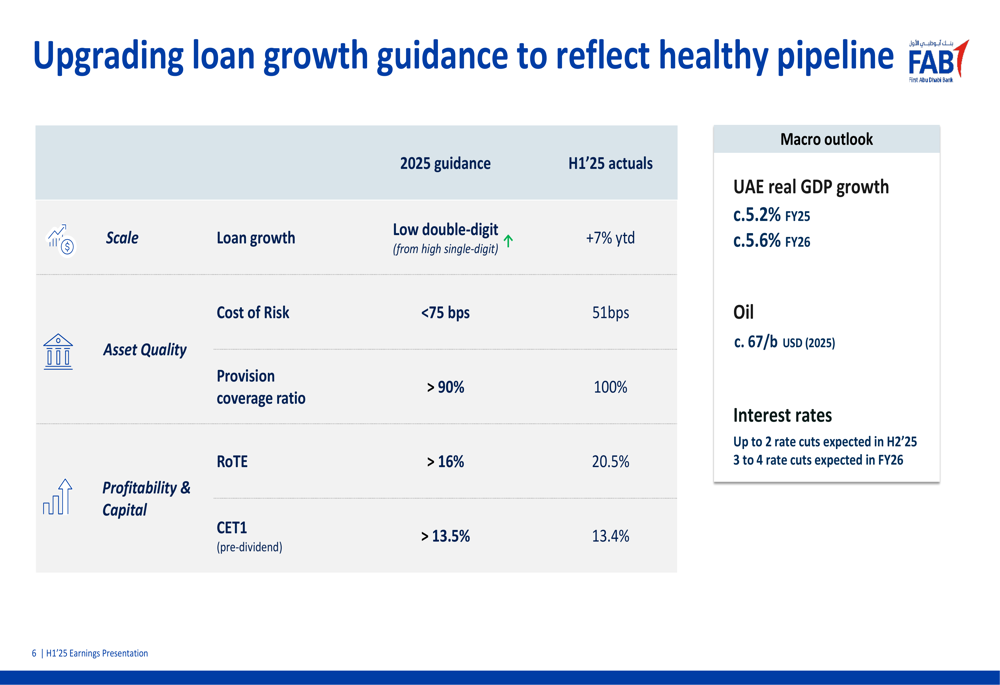
Other guidance metrics include:
- Cost of Risk: <75 bps (2025 Guidance), 51 bps (H1’25 Actuals)
- Provision coverage ratio: >90% (2025 Guidance), 100% (H1’25 Actuals)
- CET1 (pre-dividend): >13.5% (2025 Guidance), 13.4% (H1’25 Actuals)
The bank’s investment portfolio remains high-quality and well-diversified, providing a solid foundation for continued growth:
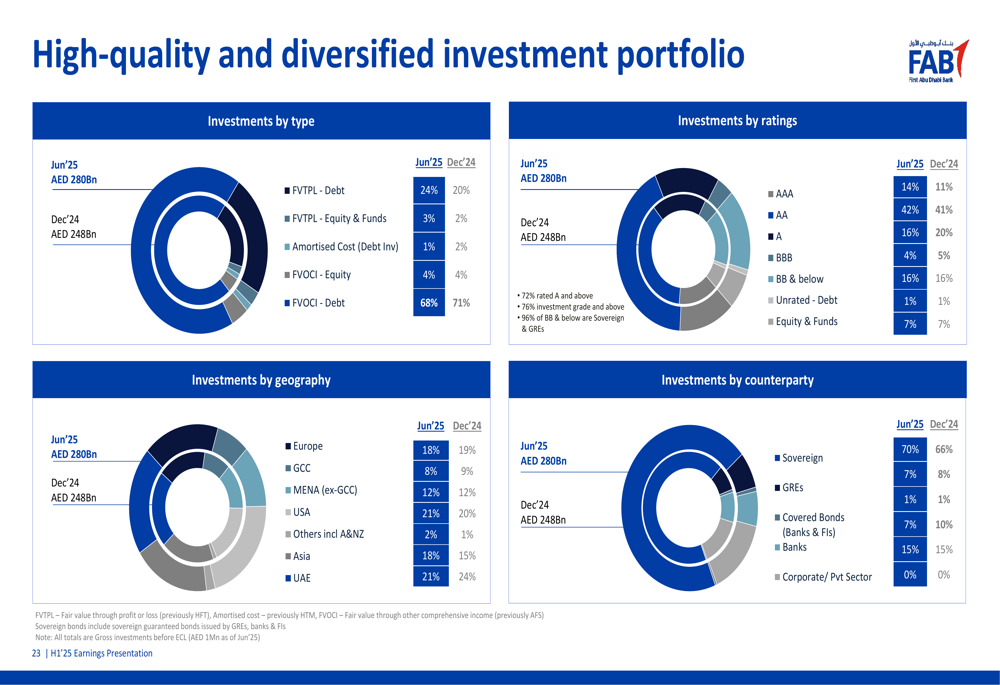
In conclusion, First Abu Dhabi Bank’s Q2/H1 2025 results demonstrate strong performance across key metrics, with record profitability, improved asset quality, and robust balance sheet growth. The bank’s strategic focus on diversification, international expansion, and digital transformation, combined with its upgraded loan growth guidance, positions it well for continued success in the remainder of 2025 and beyond.
Full presentation:
This article was generated with the support of AI and reviewed by an editor. For more information see our T&C.
